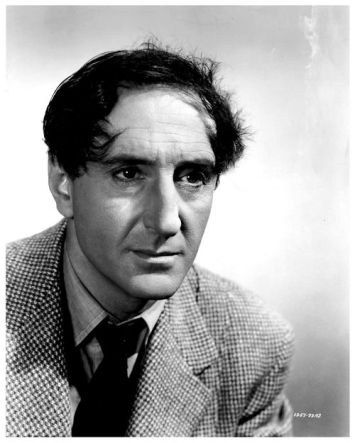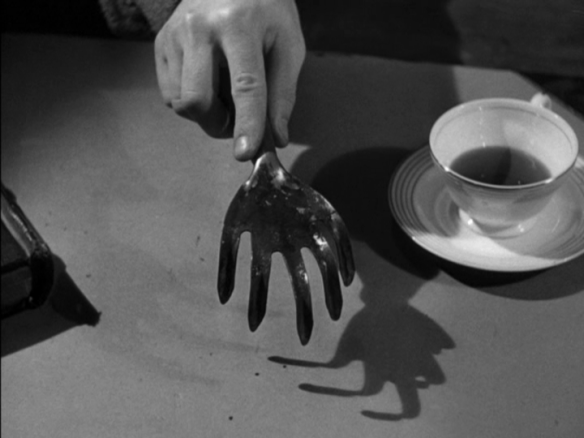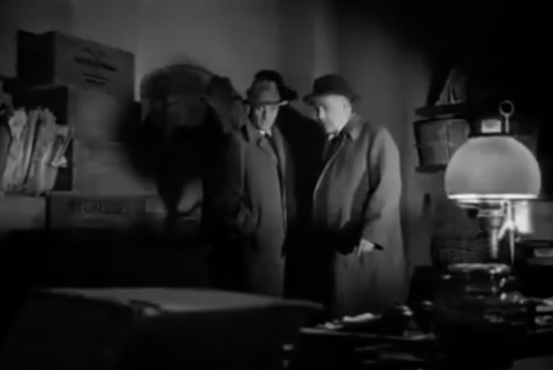A few months ago I undertook the task of watching all fourteen of the Basil Rathbone and Nigel Bruce Sherlock Holmes movies. I am very glad to say that I was successful in my little quest. Like most classic film fans, my feelings about the series are mixed. I feel that the majority of the films are highly enjoyable and very competently done for such a large amount of entries being made in a relatively brief period. And I feel that the combination of Rathbone and Bruce is an absolute delight, with it being abundantly clear that these two fine actors really held each other in very high esteem. But some of the films are bogged down in too much war propaganda, sluggish plots, and not utilising the often wonderful supporting cast to full effect. And let’s not even talk about Rathbone’s weird windswept do in a few of the films…

But today, I am going to talk about my favourite of the series. The film that, according to that golden fountain of online information, Wikipedia, is the entry that is generally agreed upon by critics and fans alike to be the best entry. The wonderfully named: The Scarlet Claw.

While the film isn’t directly based on any of Sir Arthur Conan Doyle’s original stories, it owes much to probably his most famous, and perhaps infamous offering, The Hound of the Baskervilles. Like Baskervilles, The Scarlet Claw takes place in an isolated setting and explores how superstition, fear and insanity leads to a series of murders.
The Scarlet Claw is set primarily in the tellingly named small Canadian hamlet of La Mort Rouge. The local residents have been terrorised by a glowing phantom in the nearby marshes, which seems to have claimed its first victim: Lady Penrose. Despite Lord Penrose not wanting Holmes to take the case because the famous detective does not believe the phantom to be real or responsible for the murder; Holmes soon discovers that Lady Penrose was struck in the neck with a small garden claw (thus explaining the title of the film). It soon becomes clear that Lady Penrose will not be the final victim, and that the phantom in the marsh is no phantom at all.

What I absolutely adore about this movie, and the reason that it’s my favourite, is the heavy gothic atmosphere that prevails throughout. Most of the action takes place at night, with heavy mist curling and twisting up from the deep, deadly marshes. Roy William Neill’s direction is claustrophobic at times and increases the paranoia of the characters as the film goes on. This is particularly well down during the two tragic murders that take place later on in the film, with the latter murder not being shown at all, but the dark, cramped room where the body lies and the shocked reactions of Holmes and Watson are all that is needed.

At the beginning of the film, when the church bells toll due to Lady Penrose desperately, but futilely trying to get help, Neill films all of the actors from below, so that their faces are cast in deep shadowed lines, their eyes strangely large and frightened by what lies outside of the small, shabby cafe in which they sit. This, probably purposely, calls to mind the early Universal horror movies directed by James Whale. As does the village setting and the growing fear and uncertainty of the locals.
The streets of La Mort Rouge becoming increasingly dark and filled with marsh mist, people are no longer seen clearly but exist as mysterious silhouettes. This is used later to wonderful effect when Holmes finally comes into contact with the murderer, who stands entirely in shadow, whilst shining a bright torch on the sleuth.

The supporting actors also elevate the film. With Gerald Hamer giving a brilliant performance throughout, and Kay Harding giving a sweet, understated performance as the young Marie. It is the supporting actors who provide the atmosphere for the film along with Neill’s direction and George Robinson’s gothic, but also noir-esque cinematography. The scene that takes place in the cafe between Nigel Bruce as Watson, and Hamer and other supporting actors, is a joy to watch as Watson waxes lyrical about a GK Chesterton Father Brown mystery (that actually holds a vital clue for the identity of the killer in La Mort), and Hamer hiccuping after too much wine.

I think that Basil Rathbone gives his best performance as the famous literary sleuth in this film. To be honest, Rathbone could read wallpaper instructions and I’d be happy to listen, but in this film, he perfectly balances the serious, scholarly aspects of the character as well as his dry wit and warmth towards Watson. I love how he smiles fondly at Watson when his poor friend falls down the stairs and unknowingly saves Holmes. Rathbone also makes the entire plot believable, holding all the strands of what Holmes has to do with an arched brow and a slight upturn of his mouth. I laughed uproariously when he says, “Wouldn’t you cry if your papa went away, Watson?”
As always, Bruce is an utter delight as Watson. Although he goes decidedly against the very accomplished, level headed Watson of the books, he is so likeable in the part that you forgive him very easily and happily. His ability to convey the rather oblivious, pompous aspects of the upperclass British doctor with a heart of gold and a real care for his best friend, are always welcome amongst the murder of a Holmes centred mystery. I adore the part where he falls into the bog, because he plays the comedy in such a well timed manner, that you smile whilst calling him a silly idiot.
Overall, this is the film that conveys all the best parts of the Universal cycle of Holmes mysteries, with its wonderful direction and cinematography, and how the supporting characters and Holmes and Watson are brought to being by a cast that shows why Golden Age Cinema is often such a joy to watch. And you’ll never guess who the murderer is.



This is my contribution for The 2020 Classic Literature on Film Blogathon being hosted by the wonderful Paul of Silver Screen Classics. Please do visit his blog for more information and to read all of the posts that bring the pages of our favourite novels to silver screen life.










Reblogged this on Monsters After Midnight.
LikeLiked by 1 person
Thank you! Much appreciated 😊
LikeLike
You’re welcome
LikeLiked by 1 person
You’re a good Writer.
LikeLiked by 1 person
Your review of The Scarlet Claw is spot-on and a delight to read. I must plan my evening around it soon.
I’m particularly fond of “Claw” because of the Canadian setting and even like the for-the-times epilog where Holmes waxes lyrical about my home. Although, I do giggle and refer to it as the “Canada – the missing link” speech.
LikeLiked by 1 person
Thanks Paddy! I’m so happy you enjoyed it!
Oh that epilogue is really something! I think that’s the perfect name for it 😂
LikeLike
You nailed it! The Scarlet Claw is the best of the Rathbone-Bruce Holmes films, feeling more or less like a classic Universal gothic horror film…but with Sherlock Holmes…and in Canada. So pleased to read your post, because I’ve been teased by Holmes purists who deride all of the Rathbone-Bruce movies, and dismiss The Scarlet Claw as a rehash of The Hound Of The Baskervilles. But your review explains why it’s so good and does it perfectly.
LikeLiked by 1 person
Oh boo to them! Can’t stand that kind of snobbery! So glad you enjoyed it. Thank you for your lovely comment 😊
LikeLiked by 1 person
And so what if it is a “re-hash” of Hound of the Baskervilles? There’s worse things to be a re-hash of…
LikeLiked by 1 person
You know critics, they always have to find some fault 🤷🏻♀️
LikeLiked by 1 person
And on that note, here’s looking forward to your Basil Rathbone blog-a-thon!
LikeLiked by 1 person
😁 👏🏻
LikeLike
I’ve never seen this film but it sounds positively delightful! I’ll certainly be checking it out soon.
LikeLiked by 1 person
Yay! Enjoy! 😁
LikeLiked by 1 person
I haven’t watched this in ages, but am due for a rewatch since I own the collection. Rathbone is probably my favorite Holmes, even if the films are a little ‘heav-handed’ and poor Watson is made into a buffoon just to prove a clumsy foil for Holmes’ genius.
Nice write up. 🙂
LikeLiked by 1 person
Reblogged this on blackwings666 and commented:
I have not posted anything related to SHERLOCK HOLMES in a while. Here is a great post I came across tonight and decided to reblog.
LikeLike
Great review that is also my favorite of the Rathbone Holmes series. In addition to the gothic horror atmosphere, I also find it the most chilling, as it involves the murder of a child. Which seemed a pretty rare direction to take for the time. That scene was a greatly upsetting one.
Thanks for the amazing reviews of some of the greatest films
LikeLiked by 1 person
To me, Basil was the best, bar none.
LikeLike